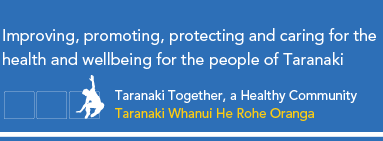Project Splice
| Click here to view the Project Splice Report pdf. |
| Click here to view the Executive Summary Report pdf. |
Hard copies of the report are available from Taranaki Base Hospital corporate reception and Hawera Hospital reception.
Questions and Answers
What is Project Splice?
Project Splice has been initiated by Taranaki District Health Board to address the projected health needs of those older people and people who have chronic/long term conditions living in the community.
Why is the project necessary?
Overall the population of Taranaki is projected to decrease by over 8% from 2001 to 2021 and will receive a reduced amount of funding in the future. We must support growth by refocusing existing services around the needs of people with long term conditions and of older people as their health deteriorates. The recommended structure involves building on the strengths of general practice and existing community based service delivery. This will improve integration between services, reduce duplication and the risk of disconnection between multiple services that may be involved in supporting a person’s care.
What are the timeframes?
There are three phases to the project. Phase One involved a whole of system review of current services. Phase Two involved seeking feedback on the best way to implement the recommendations and was completed in May 2010. Phase Three is the implementation stage, with a number of the recommendations expected to be completed by July 2012.
Why has there been a delay in implementation?
A number of the projects are dependent upon the progress of the Better Sooner More Convenient (BSMC) Business Cases of the Midlands Health Network and National Hauora Coalition, in particular the development of Integrated Family Health Centres and Whanau Ora Centres. These initiatives were at a very early stage of development when Phase Three of Project SPLICE was completed. Despite this, a multidisciplinary group that includes clinicians from primary, community and specialist services have been meeting monthly to develop the new model of care in more detail which will support implementation over coming months.
What has come out of the review?
The recommended model of service delivery for this group of people is on page 39 of the Project Splice Final Report, prepared by Auckland Uniservices Ltd.
How will the changes affect patients?
It is expected the changes will improve the experience of older people and people living with long term conditions in the community when they are accessing the health system. More services will be based locally and, once someone has visited their GP, it will be easier for them to find their way to other services they need. People with complex needs will have a designated care manager and this person will work alongside their general practice to make sure they are getting the best response possible. People with less complex needs will be able to access prompt efficient advice and support via the phone or face to face when required. All older people requiring assessment for short or long term support services (e.g. home help, day care, residential care, respite care etc.) from 1 July 2012 will receive a comprehensive assessment using interRAI.
What is InterRAI?
InterRAI been designed to be a user-friendly, reliable person-centered assessment system that informs and guides comprehensive care and service planning in community-based settings around the world. It focuses on the person’s functioning and quality of life by assessing needs, strengths, and preferences. It also facilitates referrals when appropriate. All DHBs across New Zealand are implementing a version of interRAI called 'Home Care' (known as interRAI HC). This includes two kinds of assessment - the Contact assessment (interRAI CA) which can be used for screening or non-complex assessments, and the interRAI Home Care (interRAI HC) which is suitable for clients with more complex needs. The interRAI HC can be used to assess persons with chronic needs for care, as well as with post-acute care needs (e.g. after hospitalisation or in a hospital at home situation) and must be carried out by a practising health professional. This will replace the current needs assessment tools used by our over 65's NASC and will facilitate sharing of assessment information across multiple disciplines and health providers.
What is the latest progress with Project Splice?
Midlands Health Network have recently approved their implementation plan for the Older Persons section of their BSMC Business Case, which closely aligns with the Project SPLICE plan. Three projects are now intended to be completed by July 2012. The first of these is the implementation of the interRAI assessment process for over 65's. This piece of work is progressing well with the implementation of a Project Manager and Lead Practitioner (Trainer) enabling training in the use of the new software to get underway with the current NASC team. The second project is the creation of a 'Single Point of Entry' (or SPoE) for community referrals to NASC, OPHRS, MHSOP, District Nursing and Allied Health. This SPoE will screen referrals and identify opportunities for carrying out an interRAI assessment. The final piece of work is the recruitment of 7.0FTE Care Managers who will be linked with a specific general practice population and who will provide interRAI assessment, care planning and ongoing care management to older clients with complex needs. Other longer term projects include the integration of short and long term NASC services for older people and implementation of restorative home based support services (which is being undertaken as a Midlands DHB project).
Where can I get more information?
Please contact Channa Perry on x 8566 or email channa.perry@tdhb.org.nz or Wendy Langlands on x7371 or email wendy.langlands@tdhb.org.nz.
![]() Check out other Taranaki DHB projects
Check out other Taranaki DHB projects
Last updated: Thursday, January 5, 2012



